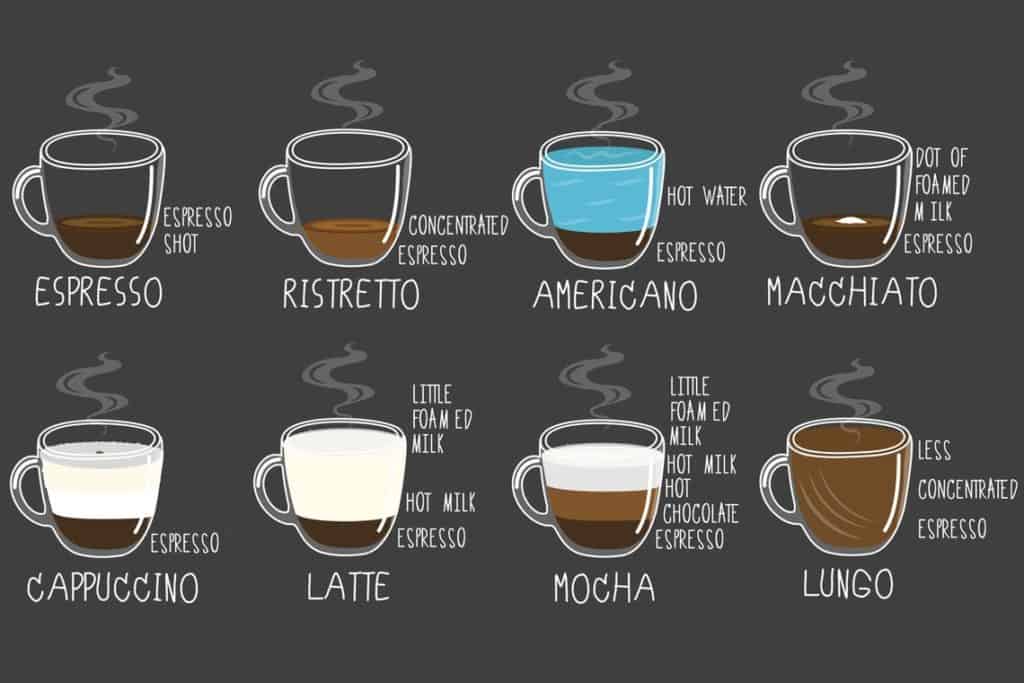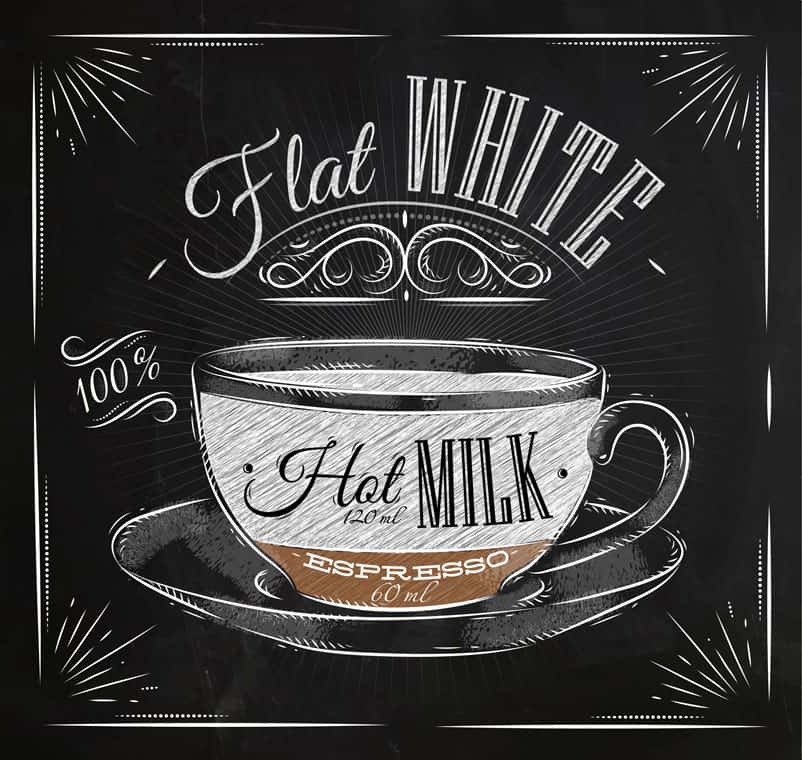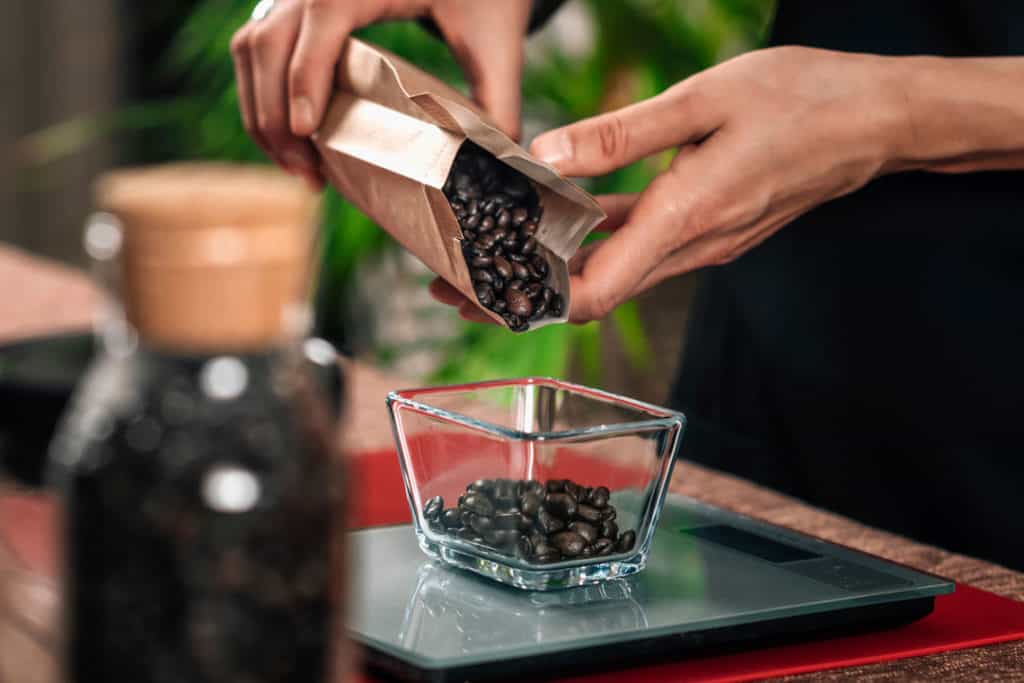The focus of this article is on two much-loved coffee drinks: cappuccino and latte. As you venture into the universe of espresso-based beverages, you might find yourself asking, what exactly is the difference between these two? Here, we’ll answer this question in detail while also touching upon their relatives: flat white and macchiato.
Cappuccino and latte have their roots in Italy. A cappuccino is named after the color of the robes of Capuchin friars, while ‘latte’ means ‘milk’ in Italian. While the ingredients of cappuccino and latte are essentially the same (espresso, steamed milk, and milk foam), they differ significantly in terms of their ratios, preparation method, appearance, and taste.
Is There Really a Big Difference Between Cappuccinos & Lattes?
In the grand scheme of things, the difference between a cappuccino and a latte might seem minimal to the untrained eye. Yet, to coffee aficionados, the distinction between the two is paramount. Here, we’ll attempt to provide some clarity.
The primary distinction lies in the ratio of the key ingredients. A cappuccino traditionally follows a 1:1:1 ratio of espresso, steamed milk, and milk foam, whereas a latte leans towards a ratio of 1:3 or 1:4 of espresso to steamed milk, with just a slight cap of milk foam on top.
The ratio difference leads to a variation in taste and texture. In a cappuccino, the taste of espresso is prominent, matching the sweetness of the milk and complementing the creaminess of the foam. The foam is abundant and thick, giving the drink a luxurious mouthfeel.
On the other hand, a latte features a milder coffee flavor due to the increased amount of milk, making it perfect for those who prefer a creamier, less intense coffee experience. The milk foam on a latte is thinner, merely crowning the top of the drink without significantly affecting its texture.
The serving size also differentiates these drinks. Given the higher milk content, lattes are typically served in larger cups compared to cappuccinos. This could make a difference if you’re looking for a more substantial beverage or, conversely, a smaller, more concentrated coffee hit.
So, while the differences may not seem monumental to a casual observer, they greatly influence the taste, texture, and enjoyment of the drink for coffee lovers. As always, the “better” choice between a cappuccino and a latte is largely subjective and comes down to personal preference. If you enjoy a stronger espresso taste with a balanced blend of milk and foam, a cappuccino may be your drink of choice. But if a creamy, milkier coffee experience is what you crave, then a latte is for you.
The table below provides a summary of key differences between these popular espresso-based coffee drinks: Cappuccino, Latte, Flat White, and Macchiato
| Cappuccino | Latte | Flat White | Macchiato | |
| Espresso | 1 part | 1 part | 1 part | 3 or 4 parts |
| Steamed Milk | 1 part | 3 or 4 parts | 2 or 3 parts | 1 part |
| Milk Foam | 1 part (thick) | Thin layer | Little or no foam | With or without (thin) |
| Flavor of Coffee | Strong and rich | Milder and smoother | Strong and bold | Intense and aromatic |
| Cup Size | Smaller cup (traditional) | Larger cup | Smaller than latte and cappuccino | Espresso cup or demitasse |
| Origin | Italy | Italy | Australia/New Zealand | Italy |
| Best For | Those who prefer a balanced blend of espresso, milk, and foam | Those who prefer a creamier, milkier coffee | Those who like a strong espresso flavor with a velvety texture | Those who prefer a strong coffee flavor with just a touch of milk |
Please note that the proportions mentioned in the table may vary according to personal preferences and regional variations.
What is a cappuccino?
A cappuccino is a delightful blend of bold and sweet. The classic version consists of three equally distributed layers: espresso, steamed milk, and a thick, creamy dome of milk foam. The strong, rich espresso counters the sweetness of the milk, resulting in a balanced and robust flavor.
To make a perfect cappuccino at home or at a café, keep these tips in mind:
- Choose fresh and finely ground coffee beans for the espresso. The freshness is key to obtaining a rich flavor.
- Use cold and fresh milk for the steaming and foaming process. This helps achieve the right consistency of foam.
- To create the creamy milk foam, a milk frother or a steam wand can be your best friend.
- When pouring the milk over the espresso, do it in a circular motion. This creates an appealing contrast between the dark and light colors.
- For an added kick, sprinkle some cocoa powder or cinnamon on top.
What is a latte?
If you prefer your coffee drinks smoother and milkier, then a latte is the way to go. A latte comprises espresso and steamed milk, topped with a thin layer of milk foam. The ratio of espresso to milk is usually 1:3 or 1:4, depending on personal preference, making the espresso milder and smoother than in a cappuccino.
To whip up a great latte at home or in a café, consider these suggestions:
- Opt for medium or dark-roast coffee beans for the espresso to provide a solid base for the milk.
- Use whole or semi-skimmed milk for the steaming process, which helps achieve a smooth and silky microfoam.
- A milk pitcher or a jug can help pour the milk over the espresso in a steady stream, yielding a uniform color.
- To customize your latte, try adding flavored syrups, sauces, or spices.
What is the difference between a cappuccino and a flat white?
Originating in Australia and New Zealand, a flat white is an espresso-based drink that features a higher ratio of coffee to milk. It contains espresso and steamed milk, with minimal or no milk foam on top, making it a contrast to cappuccino. The espresso is strong and bold, dominating the flavor of the drink.
To enjoy a flat white at home or a café:
- Use dark roast coffee beans for a rich and bold espresso.
- Steaming whole or full-fat milk results in a velvety texture and glossy surface.
- Serve the flat white in a small cup or glass, signifying its less milk volume compared to a latte or cappuccino.
- When ordering at a café, ask for little or no foam to stick to the traditional preparation.
What is the difference between a latte and a macchiato?
A macchiato is another Italian gift to coffee lovers. It consists of espresso and a small amount of steamed milk, which can be with or without milk foam on top. The ratio of espresso to milk is usually 4:1 or 3:1, providing an intense and aromatic coffee experience. The milk is often spooned over the espresso or mixed with it, creating a speckled appearance, which aligns with the meaning of ‘macchiato’ in Italian – stained or spotted.
For a home-made or café macchiato, consider:
- Using light or medium roast coffee beans for the espresso.
- Opting for skimmed or low-fat milk for the steaming process, as the focus is more on the coffee than the milk.
- Serving the drink in an espresso cup or a demitasse, which is smaller than a latte or cappuccino.
- Adjusting the foam to your preference when ordering at a café.
Conclusion
So, what’s the difference between a cappuccino and a latte? It’s all about the ratios, the preparation, and ultimately, your personal taste. Cappuccino and latte are both delightful combinations of espresso, steamed milk, and milk foam, differing in their proportions and the intensity of their flavors.
Remember, there’s no absolute right or wrong when it comes to coffee. It’s a personal journey of exploration and discovery. So, experiment with different types of coffee drinks, and find your perfect match. The world of coffee is as diverse and unique as its drinkers. Enjoy the ride!
Last Updated on June 1, 2023 by Cristina Vélez




